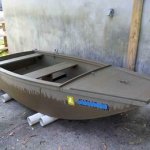You are using an out of date browser. It may not display this or other websites correctly.
You should upgrade or use an alternative browser.
You should upgrade or use an alternative browser.
Garvy
- Thread starter Allen Peterson
- Start date
Bay boats made for stability in the shallow bay waters behind barrier islands. Popular with commercial clammers and crabbers here in Jersey. As Don A noted, similar designs on mid-Atlantic coastal bays with different local names.
roy brewington
Well-known member
A true Chincoteague scow will take you thru rough water that a garvey hull won,t handle due to the rake on bottom. The best of them weren't flat bottom as those Garvey's are. Never seen any scows built as small as 10' but have seen a few 12',s. Hull shape whether Chinc. Scow or Garvey will be a wet ride in rough seas but that little 10' in ad was probably made for not much more than where one would use a pond bx. When our eastern shore scows were planked bottoms they were flat similar to garvey. But these weren't Chincoteague scows. They didn,t get that name till plywood started being used by the Hancock,s & Jesters, the best builders of the "Chincoteague Scow". A few Fiberglass boats were patterned from those hulls. The defunct Glass Boat Works Scow & a couple others. Sweet hulls which would take you there & back but better have on a rain jkt. doing it if rough. Those hulls tended to throw spray over about last 3' of hull if rough, especially quartering.
Last edited:
Steve Sanford
Well-known member
Allen~
As discussed by others here, Garveys were common work boats on Long Island and Jersey waters. I believe they were "invented" in the latter area.
The first boat I bought - when I was in high school - was a 16-foot plywood Garvey. I used it to rake clams on Great South Bay. Their strengths are: stability. shoal draft, lots of capacity per fpot of length and quick to plane. The pounding and spray in a chop are the downsides.
Here's one next to a Great South Bay Scooter in the Pattersquash Club on Bellport Bay.
[inline "19 Scooter & Garvey.jpg"]
Here is former duckboats.net member Paul Dobrosky. The big Garvey was used to tow and tend the Barnegat Bay Sneakbox in the background.
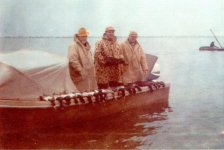
This one's on Moriches Bay (eastern LI, south shore) - owned by Ted Sadleir.
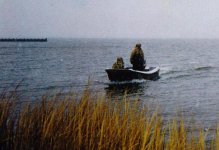
This one is decked over - to serve as a tonging boat for clamming. The cap'n is Mike Harwood, of East Islip. Such larger vessels often had inboard engines.
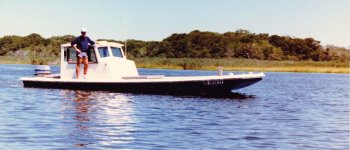
I built the blind for this 18-footer - built by Fred Wertz out of Seaford. Garveys were commonly used for "sit-up" blinds.
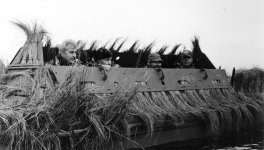
This is an actual Chincoteague Garvey - 20-ft LOA. They have some deadrise (vee) on their bottoms, especially up forward. That improvement on flat bottom vessels earned them the descriptor "chicken-breasted".

If I still lived on Long Island, I would certainly build a Garvey for myself, maybe 17-foot LOA with some deadrise up forward.
All the best,
SJS
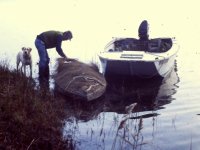
As discussed by others here, Garveys were common work boats on Long Island and Jersey waters. I believe they were "invented" in the latter area.
The first boat I bought - when I was in high school - was a 16-foot plywood Garvey. I used it to rake clams on Great South Bay. Their strengths are: stability. shoal draft, lots of capacity per fpot of length and quick to plane. The pounding and spray in a chop are the downsides.
Here's one next to a Great South Bay Scooter in the Pattersquash Club on Bellport Bay.
[inline "19 Scooter & Garvey.jpg"]
Here is former duckboats.net member Paul Dobrosky. The big Garvey was used to tow and tend the Barnegat Bay Sneakbox in the background.

This one's on Moriches Bay (eastern LI, south shore) - owned by Ted Sadleir.

This one is decked over - to serve as a tonging boat for clamming. The cap'n is Mike Harwood, of East Islip. Such larger vessels often had inboard engines.

I built the blind for this 18-footer - built by Fred Wertz out of Seaford. Garveys were commonly used for "sit-up" blinds.

This is an actual Chincoteague Garvey - 20-ft LOA. They have some deadrise (vee) on their bottoms, especially up forward. That improvement on flat bottom vessels earned them the descriptor "chicken-breasted".

If I still lived on Long Island, I would certainly build a Garvey for myself, maybe 17-foot LOA with some deadrise up forward.
All the best,
SJS

Richard Lathrop
Well-known member
Several years ago when I started working on my sailing garvey I purchased copies of all the garvey plans in the Smithsonian Small Boat collection. Today's garveys are similar but typically have higher freeboard then the traditional sailing garveys. Lines to sharpies and garvies are similar with the flat rocker bottom, difference being pointed over blunt stem of course.
Rick
Rick
Steve,
I actually just picked up a 16' Chincoteague while searching online for some history on these boats I came across this post!
Looking forward to yet another project, perfect bay runner for year-round. Thinking of going with a battleship grey Total Boat Single Stage topside. Going to remove the console, seat & convert to a tiller as well.
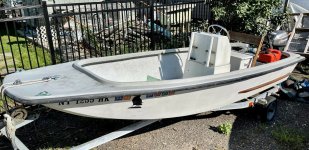
I actually just picked up a 16' Chincoteague while searching online for some history on these boats I came across this post!
Looking forward to yet another project, perfect bay runner for year-round. Thinking of going with a battleship grey Total Boat Single Stage topside. Going to remove the console, seat & convert to a tiller as well.

Steve Sanford
Well-known member
Anthony~
Fabulous! Just the right size - to toss a couple of coffin boxes inside and go anywhere you want. Small enough to horse around if the water gets a bit too skinny. And - of course - every Great South Bay garvey needs to be Battleship Grey.
Yes, I am envious!
See you soon,
SJS
Fabulous! Just the right size - to toss a couple of coffin boxes inside and go anywhere you want. Small enough to horse around if the water gets a bit too skinny. And - of course - every Great South Bay garvey needs to be Battleship Grey.
Yes, I am envious!
See you soon,
SJS
roy brewington
Well-known member
Neat scow. When you redo don,t get rid of those little fins owner installed on hull sides. Thats to break down the spray all Chincoteague Scows throw up and over sides of boat landing in cockpit at stern. Only happens in rougher water on plane. Driest place to run one in those conditions is dead center of hull, not on a stern seat. Hence center console. Those hulls will allow you to motor in about 1 ft. water with motor trimmed up. A Fifty H.P. would push it good . Ran a Glass Boat Works 18' for several years. They're remarkable little boats .
Roy- Thanks for the info much appreciated! & Definitely won't be removing those hull fins. My plan was to run a 4-stroke 30hp on her. This is the 16' Model She's in pretty good shape for her age 1985. Will have some updates soon next week after a weekend of wood duck hunting here in NY!
Thanks again
Thanks again
roy brewington
Well-known member
Any idea of original builder. Check ceiling in her good. Most were just glassed over plywood on the fiberglass hulls with no resin coating on bottom side. Stored inside or under cover they,ll last. Outside in elements or not allowing that void to thoroughly drain they,ll rot floor out from inside. 30 will push it as many in that smaller size were run with 25,s as work boats but once you load it down the 50 shines.
Steve Sanford
Well-known member
Gentlemen!
Old Wordsmith Fussbudget is having apoplexy up here in dairy country.... those "fins" are properly called spray rails.
More seriously, Roy's advice re helm location is a great idea. Play around with this vessel under different conditions and loads and see what arises. Were it mine, I'd like to stand a bit forward. I like some of the "posts" I've seen - which provide a secure handhold when stand with a (long) tiller in hand.
Also, I would put canvas on her. A nice dodger up forward with a zip-on cover to keep everything dry and secure when she's at rest.
Here's one I made for a South Bay several years ago.

You can see here more clearly second bow - unlike most of the simpler dodgers I put on my smaller gunning 'boxes - to give much more volume beneath.
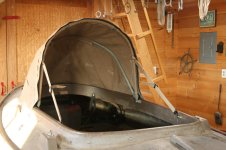
I started the zipper on the "dock" side - as this vessel was kept at a berth during the season.
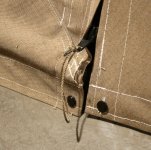
Keeping out the elements.....

Especially the kind that finds its way around every decoy and every other bit of gear - then hardens as the Mercury drops....
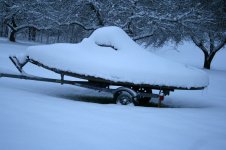
All the best!
SJS
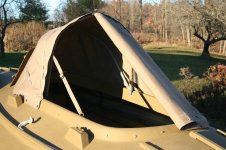
Old Wordsmith Fussbudget is having apoplexy up here in dairy country.... those "fins" are properly called spray rails.
More seriously, Roy's advice re helm location is a great idea. Play around with this vessel under different conditions and loads and see what arises. Were it mine, I'd like to stand a bit forward. I like some of the "posts" I've seen - which provide a secure handhold when stand with a (long) tiller in hand.
Also, I would put canvas on her. A nice dodger up forward with a zip-on cover to keep everything dry and secure when she's at rest.
Here's one I made for a South Bay several years ago.
You can see here more clearly second bow - unlike most of the simpler dodgers I put on my smaller gunning 'boxes - to give much more volume beneath.

I started the zipper on the "dock" side - as this vessel was kept at a berth during the season.

Keeping out the elements.....

Especially the kind that finds its way around every decoy and every other bit of gear - then hardens as the Mercury drops....

All the best!
SJS

roy brewington
Well-known member
Yes Steve , brain fart when I typed that message and I couldn't for life of me remember the proper terminology. That dodger you mentioned is a great idea if boats going to be used in rougher weather. Never had one on the scow I owned but have seen them used by others. Especiallt good for passenger's to duck behind while the Capt. eats the spray on a ROUGH TRIP!
Steve Sanford
Well-known member
Good morning, Roy~
Your description of a ROUGH TRIP reminds me of the photo that was never taken - but I wish my partner had.
A friend and I crossed about 1.5 miles of Moriches Bay in a hard northwest blow - maybe 25 or 30 knots - after a frigid morning shoot. There was ice everywhere in the marshes and was making in the open bay as Mercury was somewhere in the 20s....
I had my 2-man sneakbox - here shown on a much milder day - with a generous dodger up forward.
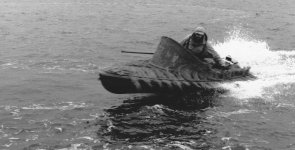
My partner was huddled comfortably, nestled with the protection of the dodger - and watching me with a grin. I was at the helm - up on my knees and giving each wave and trough careful consideration - and making sure no beam sea made it way into the cockpit. My parka, waders and lined Nokia rubber mittens kept me (mostly) dry as I took wind-driven spray ("spume"to the traditionalists) all the way back to the landing. As we made landfall, I was truly encased in ice from head to toe. Until I was able to shake off this new-found coat of armor, my partner uttered the only Hollywood line suitable to the occasion: "Oil can...." - from the Tin Man in the Wizard of Oz.
The morning's sun make short work of the icy coating on the vessel - and I'm sure we enjoyed a nice warm breakfast soon enough.
All the best,
SJS
Your description of a ROUGH TRIP reminds me of the photo that was never taken - but I wish my partner had.
A friend and I crossed about 1.5 miles of Moriches Bay in a hard northwest blow - maybe 25 or 30 knots - after a frigid morning shoot. There was ice everywhere in the marshes and was making in the open bay as Mercury was somewhere in the 20s....
I had my 2-man sneakbox - here shown on a much milder day - with a generous dodger up forward.

My partner was huddled comfortably, nestled with the protection of the dodger - and watching me with a grin. I was at the helm - up on my knees and giving each wave and trough careful consideration - and making sure no beam sea made it way into the cockpit. My parka, waders and lined Nokia rubber mittens kept me (mostly) dry as I took wind-driven spray ("spume"to the traditionalists) all the way back to the landing. As we made landfall, I was truly encased in ice from head to toe. Until I was able to shake off this new-found coat of armor, my partner uttered the only Hollywood line suitable to the occasion: "Oil can...." - from the Tin Man in the Wizard of Oz.
The morning's sun make short work of the icy coating on the vessel - and I'm sure we enjoyed a nice warm breakfast soon enough.
All the best,
SJS
roy brewington
Well-known member
Thats the stuff memories are made from. Have made a few of those ROUGH TRIPS myself. Surprising sometimes how quickly weather can turn from a chop to WHY THE HECK DID I COME OUT TODAY!

